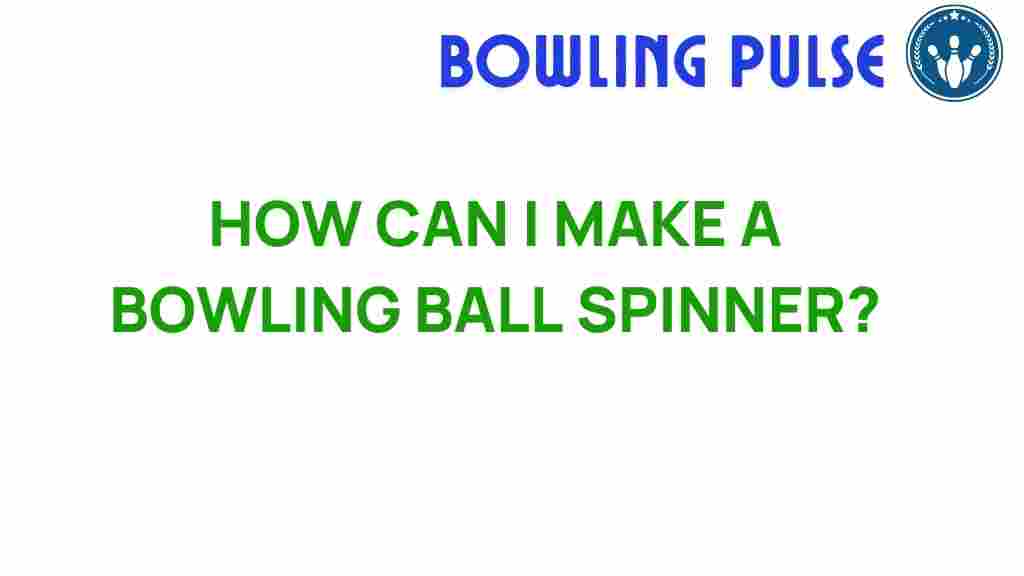Unlocking the Secrets: How to Make a Bowling Ball Spinner
Bowling is a sport that combines skill, technique, and the right equipment. One of the key aspects of improving your bowling performance is mastering the art of spin control. A bowling ball spinner can help bowlers practice their spin technique effectively. In this guide, we will explore how to create your own bowling ball spinner as a DIY project, the essential bowling techniques to consider, and tips to enhance your bowling experience with the right accessories.
Why a Bowling Ball Spinner Matters
A bowling ball spinner is a tool that allows bowlers to practice and refine their spin control. Understanding how to generate and control spin is crucial for improving your overall bowling performance. Here are a few reasons why having a spinner can be beneficial:
- Improved spin control: Practice on a spinner helps bowlers understand the mechanics of spin.
- Enhanced techniques: You can focus on different bowling techniques and how they affect the ball’s motion.
- Customizable setup: A DIY spinner allows you to tailor the equipment to your specific needs.
What You’ll Need for Your DIY Spinner
Before diving into the construction of your bowling ball spinner, gather the following materials:
- A sturdy base (plywood or a similar material)
- A motor (preferably a low-speed electric motor)
- Rubber wheels or a rotating platform
- Power supply for the motor
- Ball bearing (to reduce friction)
- Tools (drill, screws, screwdriver, etc.)
- Optional: paint or varnish for aesthetics
Step-by-Step Guide to Building Your Bowling Ball Spinner
Now that you have all the materials ready, let’s get started on building your DIY bowling ball spinner.
Step 1: Create the Base
The foundation of your spinner is crucial for stability. Use a piece of plywood or another sturdy material to create a base that is at least 2 feet by 2 feet. This size will provide ample space for the motor and spinning platform.
Step 2: Install the Motor
Next, mount your electric motor securely to the center of the base. Ensure that it is firmly attached, as it will need to support the weight of the bowling ball during operation. Use screws for a tight fit.
Step 3: Attach the Rotating Platform
Using ball bearings, create a rotating platform on top of the motor. The platform should be large enough to hold a bowling ball securely and allow it to spin freely. Make sure to test the rotation to ensure smooth operation.
Step 4: Secure the Wheels
If you’re using rubber wheels, attach them around the edge of the rotating platform. This will help grip the bowling ball and facilitate smooth spinning. If you have a platform that is already designed for spinning, you can skip this step.
Step 5: Connect the Power Supply
Connect the motor to a power supply, ensuring that all connections are secure and insulated. Test the motor to ensure it spins the platform correctly. Make any necessary adjustments to the setup for optimal performance.
Step 6: Final Touches
Once everything is assembled, you can paint or varnish the base for a polished look. Allow it to dry completely before using your bowling ball spinner.
Troubleshooting Common Issues
While using your DIY bowling ball spinner, you may encounter some common issues. Here are a few troubleshooting tips:
- Spinner not rotating: Check the power supply and ensure the motor is connected correctly.
- Excessive noise: Ensure all parts are tightly secured and lubricate the ball bearings if necessary.
- Ball slipping off: Adjust the size of the platform or add rubber grips for better traction.
Bowling Techniques to Enhance Spin Control
Once you have your bowling ball spinner set up, it’s time to focus on improving your spin control. Here are some important bowling techniques to consider:
1. Grip and Release
The way you grip and release the ball significantly affects the amount of spin you can generate. Practice different grips, such as a conventional grip or a fingertip grip, to see which gives you the best results.
2. Speed and Rotation
The speed at which you release the ball is essential for achieving the desired spin. Experiment with various release speeds while using your spinner to understand how it affects the ball’s rotation.
3. Follow-Through
A proper follow-through after releasing the ball will help maintain control and enhance the spin. Focus on extending your arm fully and keeping your hand behind the ball as you release it.
Bowling Accessories to Consider
In addition to your bowling ball spinner, there are various bowling accessories that can enhance your overall game:
- Bowling shoes: Proper footwear improves your slide and balance.
- Bowling gloves: These provide better grip and comfort during your throw.
- Ball cleaning kit: Keeping your bowling ball clean ensures optimal performance.
For more tips on bowling accessories, check out this resource.
Bowling Tips for Better Performance
To further improve your bowling performance, consider the following tips:
- Practice regularly: Consistent practice is key to mastering spin control and techniques.
- Watch your stance: Ensure your feet are properly positioned before each throw.
- Learn from professionals: Watching skilled bowlers can provide insights into effective techniques.
Conclusion
Creating a bowling ball spinner is a fantastic DIY project that can significantly enhance your bowling skills. By focusing on spin control and practicing essential bowling techniques, you can improve your overall performance and enjoy the sport even more. Remember to invest in quality bowling accessories and practice regularly to see the best results. Happy bowling!
This article is in the category Techniques and created by BowlingPulse Team
